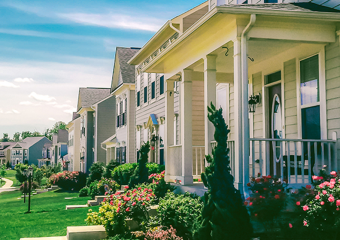Why the housing supply is so bad in the San Francisco Bay Area – Palo Alto Online
Housing affordability appears to be getting worse in the Bay Area’s nine-county region. Only 1 in 5 households could afford to purchase the region’s median-priced home of $1.2 million during the first quarter of this year, according to data collected by the California Association of Realtors. In April, the median price jumped even higher to $1.4 million. The California Association of Realtors now estimates that the average annual household income must meet or exceed $321,200 to afford a median-priced home in the Bay Area.
Statewide, the cost to buy a house has reached a new all-time high with the median price for a single-family home rising to $904,210 in April, exceeding the $900,000 benchmark for the first time in California history.
To alleviate the housing crisis, the California Department of Housing & Community Development has set an ambitious goal of adding 2.5 million new housing units across the state by 2030. But will that be enough to fix the problem?
Local housing leaders recently came together to share their insights on the Bay Area’s burgeoning housing crisis during the forum “Unlocking Potential: Tackling the Bay Area’s Housing Supply Challenge” that the Center for California Real Estate (CCRE) hosted in San Francisco on May 21.
Here’s what they had to say. Their comments have been edited for length and clarity:
Q: What are the key barriers to increasing the housing stock in the Bay Area?

Xiomara Cisneros,
senior program officer of Housing Affordability, Chan Zuckerberg Initiative
More details
Cisneros’ work at Chan Zuckerberg Initiative (CZI) focuses on improving housing affordability and access. CZI is a philanthropic organization founded by Mark Zuckerberg and Priscilla Chan in 2015 to help solve some of society’s toughest challenges, including housing.
Photo by Dale Ramos, courtesy CZI
A: I think there is a huge lack of public and political will for housing, and in particular for housing solutions. This shows up in different ways, like NIMBYism and negative headlines and manifests into our everyday public discourse and the way we think about housing. If we are just talking about the issues, then we are not talking about fixing the housing crisis. If we did, we would be talking about the solutions and how to scale those solutions.
If we’re going to make a dent in this housing crisis, we need to change the hearts and minds of the larger public. And we need to have more productive public conversations all around.

Andrew Fremier,
executive director, Metropolitan Transportation Commission & Association of Bay Area Governments
More details
Fremier is a licensed engineer who oversees the MTC/ABAG consolidated staff that supports the transportation planning, funding and coordinating agency for the San Francisco Bay Area and the council of governments for the region’s nine counties and 101 cities and towns. MTC and ABAG jointly develop and update the Bay Area’s long-range transportation, housing and land-use plan, which guides the agencies’ policy and investment decisions.
Photo by Peter Beller, courtesy California Transit Association
A: What we’ve seen over the decades is regulatory burdens that have just added onto the challenges essentially of developing good housing. It makes it more difficult and more expensive. We’ve also seen quite a bit of investor expectations … so with interest rates going up, it’s certainly been a challenge. That ties into a lack of financing and entitlements. And finally, of course, is the cost of construction materials – we’ve just seen it skyrocket.

Noni Ramos,
CEO, Housing Trust Silicon Valley
More details
Under Ramos’ leadership, Housing Trust Silicon Valley has continued to use transformative housing finance and public-private partnerships to create more equitable and affordable communities. Housing Trust is a certified Community Development Financial Institution (CDFI) working across the 14-county greater Bay Area. Since its inception in 2000, Housing Trust has invested over $522 million to create and preserve nearly 25,000 affordable homes across the region.
Photo courtesy Housing Trust Silicon Valley
A: We live in a region of abundance. This is a region that has grown. We have innovation happening on a daily basis, and yet we have not kept it up in terms of the balance between jobs and housing. We have under-invested in housing for decades, especially affordable housing. … We have a system that’s very disjointed. It takes too long for developers to be able to go from concept to actually putting shovels in the ground, and time is money and that raises the cost.

Brian Hanlon,
president & CEO, California YIMBY
More details
Hanlon is the founder and CEO of California YIMBY, a statewide pro-housing advocacy organization. He co-founded the California Renters Legal Advocacy and Education Fund (CaRLA) in 2015, which sues cities that violate state housing law. CaRLA’s litigation victory against Berkeley led to the drafting of California’s Housing Accountability Act (SB 167).
Photo courtesy California YIMBY
A: Let me start with permits. Can you get the permits to build the housing that is otherwise authorized pursuant to a local and state program? I would argue that the rule of law is a good idea, and we should have it in California. We do not when it comes to real estate. Here … every permit is discretionary.
Zoning is second. The vast majority of urbanized land in California is for detached single-family homes only. This doesn’t make sense anymore. What we really need to do is – especially in areas where there is a lot of housing demand – if (the median home price and household income ratio) is above a certain threshold, then apply different zoning standards.
Finally … we need to, with a stroke of the pen, end all of these various government-imposed costs (subsidies, impact fees) that are absolutely killing the financing for housing.

Jeff Schroeder,
senior vice president, Land, Planning & Operations, Ponderosa Homes
More details
Schroeder is responsible for all aspects of land acquisition, entitlement processing, site development and construction supervision at Ponderosa Homes. He has served as the chairman of the Building Industry Association (BIA), South Bay division and the Bay Area region. In 2023, he served as the Chairman of the Board of Directors of the California Building Industry Association (CBIA).
Photo courtesy Ponderosa Homes
A: In Sacramento this year, there were two bills that were housing creators, and eight bills that were housing killers. Still, after all these years of the housing crisis, we get more bills that are housing killers than housing creators.
It finally got through to me, these (legislators) are elected by the voters. Most voters are property owners, and most property owners have benefited from the restriction on land use and supply, so that’s a big part of it. The second thing is … none of the regulatory agencies got the message that we have a housing crisis. They just keep turning the screws and make it more difficult and more expensive to build housing.
In the Bay Area, the primary reason why we can’t build enough housing here is that we’ve restricted most of the land that you would want to build housing on from development. We have an urban growth boundary surrounding almost every county and city in the Bay Area. I call that “exclusionary zoning.” We’ve excluded people who can’t afford to buy in those towns and cities because they don’t have the income. We’ve excluded all that land from development. We’ve basically provided an implicit subsidy to every property owner within that urban growth boundary, and property values have gone up because of that.
Q: How can the tech industry and other companies contribute to solving some of these housing issues?

Xiomara Cisneros,
senior program officer of Housing Affordability, Chan Zuckerberg Initiative
A: The social contract has been disrupted in the past few years because of the intensity of the housing crisis. In the olden times, developers would build housing, tech companies would build their products and the government would provide a safety net and so forth.
Our housing crisis is so intense, we really need everyone to come together to address the crisis. This is actually really a great thing because we are able to pool these resources and leverage thought partnerships and do things like the Bay’s Future initiative (launched by the Chan Zuckerberg Initiative to preserve affordable housing and prevent displacement). We had folks from across the board – philanthropies, tech companies, community foundations, local governments … you name it, they were at the table and because of that effort, we were able to protect 73,000 tenants and were able to build and preserve 4,400 homes. That is a remarkable opportunity for philanthropy to … demonstrate to the public and private sectors what’s possible.

Andrew Fremier,
executive director, Metropolitan Transportation Commission & Association of Bay Area Governments
A: We do think large corporations that really have a lot of high value assets would be well-served to produce support and employee housing because that’s certainly giving back to the housing-workforce imbalance. It’s one of the key structures that could really be dealt with if corporations got involved.
Making some changes to the tax codes that allow for corporations that don’t pay a lot of taxes – or any taxes – to invest or require them to invest in this endeavor also would be great.

Noni Ramos,
CEO, Housing Trust Silicon Valley
A: The Housing Trust is a nonprofit lender. We really serve as an intermediary between capital and communities. Back in 2017, the folks who were at the Housing Trust at the time came up with a concept of doing just what this question is trying to get at: how to bring a value proposition to employers, particularly in Silicon Valley. We launched the Tech Equity Community and Housing Fund. The fund’s purpose is to bring investment capital from large corporate entities. We have investors like LinkedIn, Cisco and NetApp.
More recently, in 2019, we saw a lot of encouragement from the governor in particular for corporations to really be part of the solution of how we address the housing crisis. So in that year, we started to work with Google and Apple as investors in the tech fund. These entities have really spent a considerable amount, not only financial resources but human resources, to learn about affordable housing and the overall housing ecosystem in the Bay Area, and try to be part of the solution.
What we want to do is make sure those entities stay engaged and that we can continue to bring more solutions to the field at the same time we are seeing cuts potentially at the state level and across the board. We need to be able to leverage federal resources, and the way to do that is to have investment at home. If we have capital here, that will actually help us leverage federal sources.

Brian Hanlon,
president & CEO, California YIMBY
A: The main impact of the tech industry is that they are some of the most profitable and productive companies in the history of humanity, and they are located here. … If all the tech companies do is massively increase demand for housing and then help a few hundred homes go up a year, they are just facilitating the evisceration of the middle class in the Bay Area. The most valuable thing they can do by far is to get more engaged in politics and advocacy and fix the market. Philanthropy is not going to save us here.
Look at Houston and how they more than halved homelessness in a relatively short time period. It’s because the market there mostly works. The overall thing that swamps every other impact is they build a lot of housing. It’s not just sprawl. They’re massively densifying existing neighborhoods and redeveloping them, and that is why it is much, much, much more affordable than here.

Jeff Schroeder,
senior vice president, Land, Planning & Operations, Ponderosa Homes
A: I appreciate the leadership that comes from the tech industry on this, and I think we need more of it. The financial impact of it is pretty marginal. We’re not talking about a lot of money that’s going to make much happen, but if we can get leadership out of them that helps.
Frankly, I don’t think anyone buys a tech stock because they are investing in housing, especially in the Bay Area. They don’t run their companies based on housing in the Bay Area. A lot of their people can live anywhere now, so they are moving to other places where they can have a better lifestyle, and some of those companies are leaving. I think we need to make sure we can continue to accommodate those enterprises in the Bay Area. We’re always going to have an edge, but you can’t take it for granted forever.
Q: How can we ensure housing in the Bay Area is inclusive?

Xiomara Cisneros,
senior program officer of Housing Affordability, Chan Zuckerberg Initiative
A: It is important to underscore that the private sector and the public sector are really important players in this space. If anything, the public sector needs to have a bigger role in this space. I do think we need different housing at all levels of affordability and that includes market-rate housing. We also need different housing types from big, multi-family buildings to ADUs to middle-scale and to remove the obstacles to make it come online quickly.
It’s also important to acknowledge that the market won’t serve everyone, like the unhoused and those on the verge of homelessness, those who are disabled. That is why it’s important to have that innovation and leadership in the public sector and to have those funds.
It doesn’t mean we need to have tons of layers of subsidies. We need to think of how we can be more efficient with those capital uses.

Andrew Fremier,
executive director, Metropolitan Transportation Commission & Association of Bay Area Governments
A: There’s a housing crisis at all levels. We are very supportive of folks that are building market-rate housing. The Bay Area Housing Finance Authority’s primary function is really to deal with providing housing for low- to moderate -income households.
What we’ve done through the process of scaling up the organization since 2019 is to put together a real inclusive expenditure plan. We have an equity framework that really prioritizes new construction housing investments for those who need it, mostly unhoused residents that are facing eviction or those who are one paycheck away (from being homeless).
And then, of course, our preservation projects are really designed to be investments in historically disinvested communities, of which there are quite a few around the region. It’s pretty striking how deep the challenges are, how important those communities are to making the Bay Area vibrant.

Noni Ramos,
CEO, Housing Trust Silicon Valley
A: In terms of who votes and who has the power, we know that homeowners make up a lot of the folks who are voting. How do we ensure that the voices of communities that have not historically been able to be heard, who have really suffered the consequences of the benefits that have been built by exclusionary policies like disinvestment or not sharing resources broadly across communities are heard?
So how do we ensure folks can stay where they currently are living, where they have built communities, where they have family? For too long, we’ve just been saying to those folks, “Well, just move to where you can afford. Sorry that where you live today, you can’t afford anymore. Just go over there and leave this place for the new folks that can come in.”
For too long, that has been the strategy and that strategy has had really negative consequences on our communities. We need to ensure that those folks can stay and that we are really prioritizing developments that are meeting the needs of residents in those communities.

Brian Hanlon,
president & CEO, California YIMBY
A: Why do we assume that the only way to provide housing for low- and middle-income people is to build brand new housing? If we want to have inclusive communities, we should look at places that have those things. And what you typically see is robust regional home building.
You don’t actually need to build specifically for given income categories because two things happen when you build market-rate housing: One, it’s just more homes that actual people can live in and that reduces overall pressure, and two, it creates a chain of moves. In neighborhoods that build new housing, it sets off a chain of moves, where lower-income people benefit immediately because they are then able to move into housing that a moderate-income person vacated to move into other housing.

Jeff Schroeder,
senior vice president, Land, Planning & Operations, Ponderosa Homes
A: How do we build inclusive housing? I’ve done quite a few projects with inclusionary zoning. It’s just part of the process. There’s ways to do it that’s really efficient, but let’s all agree that if I have a 1,000-unit project and I have to set 200 of them aside for inclusionary zoning, that’s 200 less market-rate units. So we’re reducing the number of market-rate units, which drives up the price. It’s simple economics. I appreciate past efforts to put money into some of these housing bonds that have been floated out there, but my criticism about that whole process is if we’re not designating more land for that money, that money is just going into the existing pot for land that is available and driving up the cost. We need to be more thoughtful about that … and designate new land for housing so we don’t oversubscribe the market.
The Silicon Valley Association of Realtors (SILVAR) contributed to this article. SILVAR is a professional trade organization representing 5,000 Realtors and affiliate members engaged in the real estate business on the Peninsula and in the South Bay. SILVAR promotes the highest ethical standards of real estate practice, serves as an advocate for homeownership and homeowners, and represents the interests of property owners in Silicon Valley.




